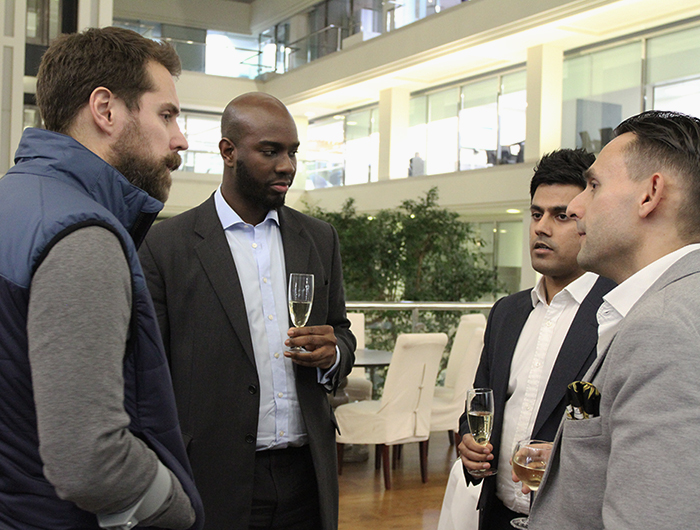Executive MBA (Fashion) at London College of Fashion continued their series of events with a fashion business panel discussion on the divide between creative vision and commercial reality, bringing together a panel of industry experts who try and manage the relationship between money and unique vision on a daily basis.

EMBA Panel Discussion: The Divide Between Creative Vision And Commercial Reality.
Chaired by James Clark, Acting Course Leader for Executive MBA and Senior Lecturer in BA (Hons) Buying and Merchandising, the discussion rook place at consumer media company DMGT plc. in west London, the same building that houses The Mail, Metro and Independent newspapers. The panel was made up of Kirsty Herd – Founder and Creative Director of Camomile Concepts, Tyrone Sarucan – Head of Finance at PVH UK, Sally Heath-Minto – Ecommerce Director at New Look, Professor Dilys Williams – Director of Centre for Sustainable Fashion at LCF, and Carl Hazeley and Jamie Baja, both Equity Research Analysts at Goldman Sachs.
The panel debated the ongoing challenge of balancing creativity and financial prudence, and how that is made harder by the changing nature of range assortment planning. The group collectively agreed that fashion businesses must collaborate with their consumers who will have their own interpretation of the relationship between creativity and value for money from the product ranges that they choose to buy.

EMBA Panel Discussion: The Divide Between Creative Vision And Commercial Reality.
The panel also questioned how this relationship should develop with an empowered digital native consumer increasingly influencing product range assortment decisions. We spoke to James Clark following the event, he said:
The discussion focused on finding the balance between creativity and control within fashion businesses and generated a lively debate. For me, the key themes that emerged were that while there is a potential imbalance it is collaboration within the value system that ensures success. Some of that collaboration can come from understanding the pressures faced by differing roles within the business, but most importantly fashion executives must focus on the ultimate control that is in the hands of the consumer.
This key point is often overlooked as businesses are focused on connecting the upstream supply chain. My biggest takeaway from the debate was to remove silo mentalities from decision making requires a change in thought on how consumer control relates not just to product decision making but to those of finance, logistics and data analysis for example.
The global fashion industry is valued at $3 trillion, despite this size and the influence of commerce, the natural fluidity of cultural and trend evolution requires a fashion business to manage its creative direction and financial controls assiduously. The nature of this control is at the heart of effective product management from the high street through to the luxury of haute couture. So how do they manage the artistic demand vs product budgeting? EMBA student Joanna Watson was asking very similar questions, we spoke to her after the panel discussion. She said:
This panel debate concluded some intense study days for the Finance Unit. We were learning about how companies manage flows of money to run a business, and ultimately increase shareholder wealth, in what could be said to be a highly competitive and consumer driven market. It was a lively panel debate that questioned some key fashion concerns: how much should creatives know about the financial climate and should this influence them? How closely should designers follow customer demand as opposed to their own vision? Should sustainability practices guide the designer? And for that matter, what comes first, responsibility to the plant or to the interests of the shareholders? I only wish there had been more time for this ongoing discussion. The willingness in the room from each side was evident, and clear thinking and collaboration will be key in an uncertain market.

EMBA Panel Discussion: The Divide Between Creative Vision And Commercial Reality.
We also spoke to another EMBA student, Songhee Lee, who said:
I think all of us are in the dilemma between creativity and commerciality within the fashion industry. No matter the size of the business, it is never easy to balance those two matters and making right decisions. The debate many different answers, not just one clear answer. The panel discussion was not only very interesting because we got to hear from various perspectives but because it also gave a great insight into how they deal with it in different areas and positions.
- More information on Executive MBA (Fashion) and BA (Hons) Buying and Merchandising
- LCF is Global
- Find out more about other undergraduate courses at LCF
- Find out more about postgraduate courses at LCF
- LCF Open Days and Events
- Find out more about Funding and Mentoring
- More LCF News stories
- More information on LCF Careers
- Want to write for LCF News? Send your pitches to communications@fashion.arts.ac.uk



